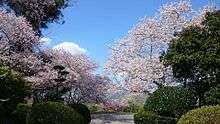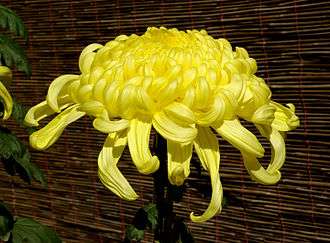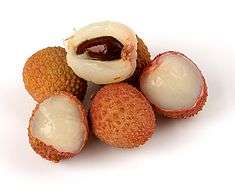Flora of Japan
The flora of Japan comprises a large assemblage of plant species which can be found in Japan, such as sakura, katsura, momiji and azalea. There are many species which are endemic to Japan.

Diversity
Japan has significant diversity in flora. Of approximately 5,600 total vascular plant species, almost 40% are endemic.[1] This richness is due to the significant variation in latitude and altitude across the country, a diversity of climactic conditions due to monsoons, and multiple geohistorical incidences of connections with the mainland.[2]
Vegetation Types
Japan consists of roughly vegetation zones that are delineated by temperature and precipitation: the alpine region, subalpine region, summer-green broad-leaved forest region and evergreen broad-leaved forest region.[3][4]
Due to its substantial length of over 3,000 km from north to south and its mountain ranges that can exceed 3,000 meters, Japan's vegetation varies by latitude and by altitude. Evergreen forests tend to appear in the southern half of the Japanese mainland, with broad leaf forests, subalpine and alpine appearing with increasing frequency to the north and near mountains.[3][4]
Evergreen broad-leaved forest region
The evergreen forest zone can be found along the coasts of the southern half of Japan and is most common zone in the Ryukyu Islands, Shikoku and, Kyushu as well as parts of southwestern Honshu with equal longitude.[3] This region rises up to an elevation of 750 meters near Tokyo.[4] At the coasts, the dominant forest canopy species are Castanopsis cuspidata and Machilus thunbergii. Inland, trees belonging to the genus Quercus are dominant. In lower layers, trees and shrub species include Camellia japonica, Neolitsea sericea, Aucuba japonica, and Eurya japonica. It is a characteristic of this zone that all these are evergreen species.[4]
Summergreen broad-leaved forest region
These forests can be found in central Japan above 1,000 meters altitude and throughout parts of Hokkaido at elevations between 700 and 1,600 meters. These forests are also called Fagus crenata forests due to the prevalence of this tree species. On the western side, common species include Daphniphyllum macropodum, Cephalotaxus harringtonii, and Aucuba japonica. On the eastern side facing the Pacific Ocean, important species include Ulmus japonica, Arachniodes standishii , and Laportea macrostachya. This region has been particularly affected by human development and clearing of natural forests. Cleared lands tend to be replanted with Larix kaempferi, Cryptomeria japonica , and Chamaecyparis obtusa.[4]
Subalpine and alpine regions
In Honshu, from 1,600 to 2,500 meters, and Hokkaido at slightly lower altitudes, character species in the subalpine zone are Vaccinium vitis-idaea, Vaccinium ovalifolium, Neottia cordata, Coptis trifolia. Distinguishing trees include Abies mariesii, Larix kaempferi, and Tsuga diversifolia.[4]
Above 2500 meters, vegetation has to contend with significant snowfall and high winds. Genera that can survive in these conditions include Phyllodoce and Harrimanella.[4]
Cultural significance
| Title | Symbol | Picture |
|---|---|---|
| National tree | Japanese Cherry blossom (Prunus serrulata) |  |
| National flower | Florist's daisy/Yellow Chrysanthemum (Chrysanthemum morifolium) |  |
| National fruits | Lychee (Litchi chinensis) Japanese persimmon (Diospyros kaki) |   |
| National vegetable | Daikon (Raphanus sativus longipinnatus) |  |
| National crops | Soybeans (Glycine max) |  |
List
- Cercidiphyllum
- Japanese maple
- Azalea
- Chrysanthemum
- Reynoutria japonica
- Japanese beech
- Konara
- Cherry blossom
- Pinus pumila
- Hinoki cypress
- Japanese red pine
- sakaki evergreen
- Japanese red cedar
- Pinus luchuensis
- Cryptotaenia japonica
- Acer ginnala
- Wasabi
- Nandina
- Japanese holly
- Japanese iris
- Juniperus procumbens
- Pittosporum tobira
- Hosta
- Styrax japonicus
- Wisteria floribunda
- Japanese black pine
- Prunus × yedoensis
- Pinus amamiana
- Acer japonicum
- Sciadopitys
- Myoga
- Chamaecyparis pisifera
- Gastrodia amamiana
References
- Uemura, Shigeru (1989). "Snowcover as a Factor Controlling the Distribution and Speciation of Forest Plants". Vegetatio. 82 (2): 127–137. ISSN 0042-3106. JSTOR 20038472. Retrieved 2020-08-07.
- Government of Japan (2014). "Fifth National Report of Japan to the Convention on Biological Diversity". Missing or empty
|url=(help) - "The Wildlife in Japan" (PDF). Ministry of the Environment. 2015. Retrieved 2020-07-28.
- Miyawaki, Akira (1984). "A Vegetation~Ecological View of the Japanese Archipelago". Bulletin of the Institute of Environmental Science and Technology. 11: 85–101.